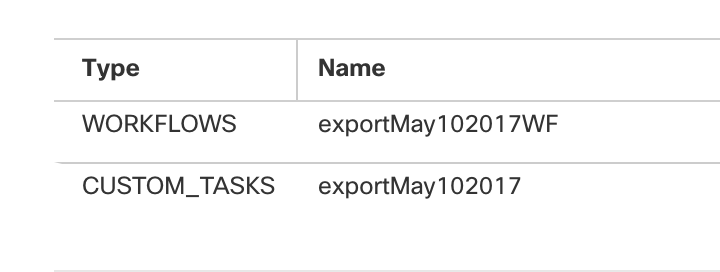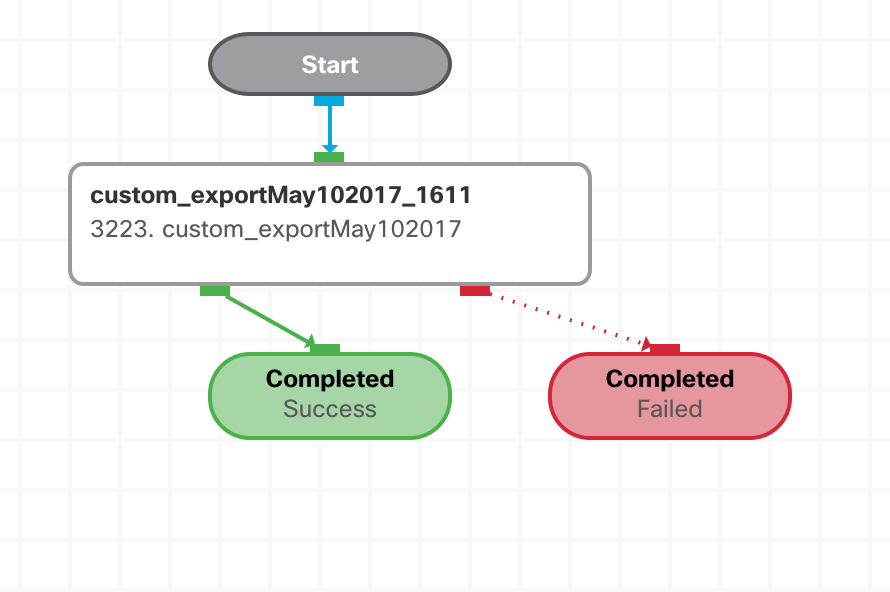- Cisco Community
- Technology and Support
- Data Center and Cloud
- UCS Director
- UCS Director Knowledge Base
- UCSD - APIC export an existing Global Contract from an Existing Tenant to another Tenant
- Subscribe to RSS Feed
- Mark as New
- Mark as Read
- Bookmark
- Subscribe
- Printer Friendly Page
- Report Inappropriate Content
- Subscribe to RSS Feed
- Mark as New
- Mark as Read
- Bookmark
- Subscribe
- Printer Friendly Page
- Report Inappropriate Content
05-13-2017 07:39 AM - edited 03-01-2019 06:46 AM
Workflow Name: | ACI/APIC - Create Export Contract |
Description: |
Following parameter are required
|
| Compatible UCS Director Versions: | UCSD 6.x.x.x |
Category: | ACI, APIC
|
Instructions for Use:
- 1. Download the attached .ZIP file below to your computer.
*Remember the location of the saved file on your computer. - 2. Unzip the file on your computer. Should end up with a .WFD file.
- 3. Log in to UCS Director as a user that has
"system-admin" privileges. - 4. Navigate to "Policies-->Orchestration" and click on
"Import". - 5. Click "Browse" and navigate to the location on your
computer where the .WFD file resides. Choose the .WFD file and click "Open". - 6. Click "Upload" and then "OK" once the file
upload is completed. Then click "Next". - 7. Click the "Select" button next to "Import
Workflows". Click the "Check All" button to check all checkboxes
and then the "Select" button. - 8. Click "Submit".
- 9. A new folder should appear in
"Policies-->Orchestration" that contains the imported workflow.
You will now need to update the included tasks with information about the
specific environment.
The Import of the workflow (Name of workflow and custom task):

The workflow:

Workflow input:

Workflow variables:

The custom Script:
importPackage(java.util);
importPackage(java.lang);
importPackage(java.io);
importPackage(com.cloupia.feature.apic);
importPackage(com.cloupia.service.cIM.inframgr);
importPackage(com.cloupia.lib.connector.account);
importPackage(com.cloupia.lib.util);
importPackage(org.apache.commons.httpclient);
importPackage(org.apache.commons.httpclient.cookie);
importPackage(org.apache.commons.httpclient.methods);
importPackage(org.apache.commons.httpclient.auth);
importPackage(org.apache.commons.httpclient.protocol);
importClass(org.apache.commons.httpclient.protocol.SecureProtocolSocketFactory);
importPackage(com.cloupia.lib.cIaaS.vcd.api);
/****************************************************************************************/
/** **/
/** !!! IMPORTANT NOTE !!! **/
/** **/
/** **/
/** THIS SCRIPT REQUIRES A MINIMUM UCS DIRECTOR VERSION OF 5.4.0.0 **/
/** **/
/****************************************************************************************/
//----------------------------------------------------------------------------------------
// ### FUNCTIONS ###
//----------------------------------------------------------------------------------------
//----------------------------------------------------------------------------------------
//
// Author: Russ Whitear (rwhitear@cisco.com)
//
// Function Name: httpRequest()
//
// Version: 3.0
//
// Modifications: Added HTTP header Connection:close to execute method to overcome the
// CLOSE_WAIT issue caused with releaseConnection().
//
// Modified SSL socket factory code to work with UCS Director 5.4.0.0.
//
// Description: HTTP Request function - httpRequest.
//
// I have made the httpClient functionality more object like in order to
// make cloupia scripts more readable when making many/multiple HTTP/HTTPS
// requests within a single script.
//
// Usage: 1. var request = new httpRequest(); // Create new object.
//
// 2. request.setup("192.168.10.10","https","admin","cisco123"); // SSL.
// or: request.setup("192.168.10.10","http","admin","cisco123"); // HTTP.
// or: request.setup("192.168.10.10","https"); // SSL, no basicAuth.
// or: request.setup("192.168.10.10","http"); // HTTP, no basicAuth.
//
// 3. request.getRequest("/"); // HTTP GET (URI).
// or: request.postRequest("/","some body text"); // HTTP POST (URI,BodyText).
// or: request.deleteRequest("/"); // HTTP DELETE (URI).
//
// (optional) 4. request.contentType("json"); // Add Content-Type HTTP header.
// or: request.contentType("xml");
//
// (optional) 5. request.addHeader("X-Cloupia-Request-Key","1234567890"); // Any Header.
//
// 6. var statusCode = request.execute(); // Send request.
//
// 7. var response = request.getResponse("asString"); // Response as string.
// or: var response = request.getResponse("asStream"); // Response as stream.
//
// 8. request.disconnect(); // Release connection.
//
//
// Note: Be sure to add these lines to the top of your script:
//
// importPackage(java.util);
// importPackage(com.cloupia.lib.util);
// importPackage(org.apache.commons.httpclient);
// importPackage(org.apache.commons.httpclient.cookie);
// importPackage(org.apache.commons.httpclient.methods);
// importPackage(org.apache.commons.httpclient.auth);
// importPackage(org.apache.commons.httpclient.protocol);
// importClass(org.apache.commons.httpclient.protocol.SecureProtocolSocketFactory);
// importPackage(com.cloupia.lib.cIaaS.vcd.api);
//
//----------------------------------------------------------------------------------------
var httpRequest = function () {};
httpRequest.prototype.setup = function(serverIp, transport, username, password) {
this.serverIp = serverIp;
this.transport = transport;
this.username = username;
this.password = password;
this.httpClient = new HttpClient();
// Decide whether to create an HTTP or HTTPS connection based on "transport".
if( this.transport == "https" ) {
this.httpClient = CustomEasySSLSocketFactory.getIgnoreSSLClient(this.serverIp, 443);
this.httpClient.getParams().setCookiePolicy("default");
} else {
// Create new HTTP connection.
this.httpClient.getHostConfiguration().setHost(this.serverIp, 80, "http");
}
this.httpClient.getParams().setCookiePolicy("default");
// If username and password supplied, then use basicAuth.
if( this.username && this.password ) {
this.httpClient.getParams().setAuthenticationPreemptive(true);
this.defaultcreds = new UsernamePasswordCredentials(this.username, this.password);
this.httpClient.getState().setCredentials(new AuthScope(this.serverIp, -1, null), this.defaultcreds);
}
};
httpRequest.prototype.contentType = function(contentType) {
this.contentType = contentType;
this.contentTypes = [
["xml","application/xml"],
["json","application/json"]
];
for( this.i=0; this.i<this.contentTypes.length; this.i++)
if(this.contentTypes[this.i][0] == this.contentType)
this.httpMethod.addRequestHeader("Content-Type", this.contentTypes[this.i][1]);
};
httpRequest.prototype.addHeader = function(headerName,headerValue) {
this.headerName = headerName;
this.headerValue = headerValue;
this.httpMethod.addRequestHeader(this.headerName, this.headerValue);
};
httpRequest.prototype.execute = function() {
// Connection:close is hard coded here in order to ensure that the TCP connection
// gets torn down immediately after the request. Comment this line out if you wish to
// experiment with HTTP persistence.
this.httpMethod.addRequestHeader("Connection", "close");
this.httpClient.executeMethod(this.httpMethod);
// Retrieve status code.
this.statusCode = this.httpMethod.getStatusCode();
return this.statusCode;
}
httpRequest.prototype.getRequest = function(uri) {
this.uri = uri;
// Get request.
this.httpMethod = new GetMethod(this.uri);
};
httpRequest.prototype.postRequest = function(uri,bodytext) {
this.uri = uri;
this.bodytext = bodytext;
// POST Request.
this.httpMethod = new PostMethod(this.uri);
this.httpMethod.setRequestEntity(new StringRequestEntity(this.bodytext));
};
httpRequest.prototype.getResponse = function(asType) {
this.asType = asType;
if( this.asType == "asStream" )
return this.httpMethod.getResponseBodyAsStream();
else
return this.httpMethod.getResponseBodyAsString();
};
httpRequest.prototype.deleteRequest = function(uri) {
this.uri = uri;
// Get request.
this.httpMethod = new DeleteMethod(this.uri);
};
httpRequest.prototype.disconnect = function() {
// Release connection.
this.httpMethod.releaseConnection();
};
// main()
//var apic_account_name = "ACIAPIC";
var apic_account_name = String(input.aciApicAccountName);
var store = CredentialStore.getStore(new ApicInfraAccountConfig().getClass());
var apic_account = store.getCredential(apic_account_name);
var apicIP = apic_account.getServer();
var apicLogin = apic_account.getUsername();
var apicPassword = apic_account.getPassword();
//output.APIC_ACCOUNT = apic_account_name;
// Place individual variables here...
//var New = input.New;
//
var requestURI = "/api/mo/.json";
// Create JSON login data.
var aaaUser = new TreeMap();
aaaUser.put("aaaUser",new TreeMap());
aaaUser.get("aaaUser").put("attributes",new TreeMap());
aaaUser.get("aaaUser").put("children",new ArrayList());
aaaUser.get("aaaUser").get("attributes").put("name",apicLogin);
aaaUser.get("aaaUser").get("attributes").put("pwd",apicPassword);
var loginUri = "/api/mo/aaaLogin.json";
var loginData = JSON.javaToJsonString(aaaUser, aaaUser.getClass());
var newTenantName = String(input.newTenantName);
var res1 = newTenantName.split("@");
var newTenantNameX = res1[1];
var newContractName = String(input.newContractName);
var str = String(input.Contract);
var res = str.split("@");
var originalTenantName = "uni/tn-"+res[1]+"/brc-"+res[2];
var originalContractName = res[2];
var res2 = "uni/tn-"+res1[1]+"/cif-"+newContractName;
// PASTE APIC JSON REQUEST DATA HERE...
var javaMap = new TreeMap();
javaMap.put("vzCPIf",new TreeMap());
javaMap.get("vzCPIf").put("attributes",new TreeMap());
javaMap.get("vzCPIf").put("children",new ArrayList());
javaMap.get("vzCPIf").get("attributes").put("dn",res2);
javaMap.get("vzCPIf").get("attributes").put("name", newContractName);
javaMap.get("vzCPIf").get("attributes").put("status","created");
javaMap.get("vzCPIf").get("children").add(new TreeMap());
javaMap.get("vzCPIf").get("children").get("0").put("vzRsIf",new TreeMap());
javaMap.get("vzCPIf").get("children").get("0").get("vzRsIf").put("attributes",new TreeMap());
javaMap.get("vzCPIf").get("children").get("0").get("vzRsIf").put("children",new ArrayList());
javaMap.get("vzCPIf").get("children").get("0").get("vzRsIf").get("attributes").put("tDn",originalTenantName);
javaMap.get("vzCPIf").get("children").get("0").get("vzRsIf").get("attributes").put("status","created");
var requestData = JSON.javaToJsonString(javaMap, javaMap.getClass());
//
requestData = requestData+""; // Convert requestData from object to string.
requestData = requestData.replace(/\\/g,""); // Overcome some APIC ugliness.
logger.addInfo("Original Contract Name: " + originalContractName);
logger.addInfo("Original Tenant Name: " + res[1]);
logger.addInfo("New Tenant Name: " + newTenantNameX);
logger.addInfo("New Contract Name: " + newContractName);
logger.addInfo("requestData: " +requestData);
var request = new httpRequest();
request.setup(apicIP,"https");
request.postRequest(loginUri,loginData);
request.contentType("json");
var statusCode = request.execute();
var response = request.getResponse("asString");
logger.addInfo("Status code: " +statusCode );
logger.addInfo("Response: " +response );
request.postRequest(requestURI,requestData);
var statusCode = request.execute();
var response = request.getResponse("asString");
logger.addInfo("Status code: " +statusCode );
var responseData = JSON.getJsonElement(response,null);
if( responseData.has("imdata") && responseData.get("imdata").size() ) {
for( var i = 0; i < responseData.get("imdata").size(); i++ ) {
if( responseData.get("imdata").get(i).has("error") ) {
if( responseData.get("imdata").get(i).get("error").has("attributes") ) {
if( responseData.get("imdata").get(i).get("error").get("attributes").has("code") ) {
logger.addError("APIC Error Code: " + responseData.get("imdata").get(i).get("error").get("attributes").get("code") );
}
if( responseData.get("imdata").get(i).get("error").get("attributes").has("text") ) {
logger.addError("APIC Error Text: " + responseData.get("imdata").get(i).get("error").get("attributes").get("text") );
}
}
// Set failed.
ctxt.setFailed("Request failed.");
}
}
}
request.disconnect();
Find answers to your questions by entering keywords or phrases in the Search bar above. New here? Use these resources to familiarize yourself with the community:
